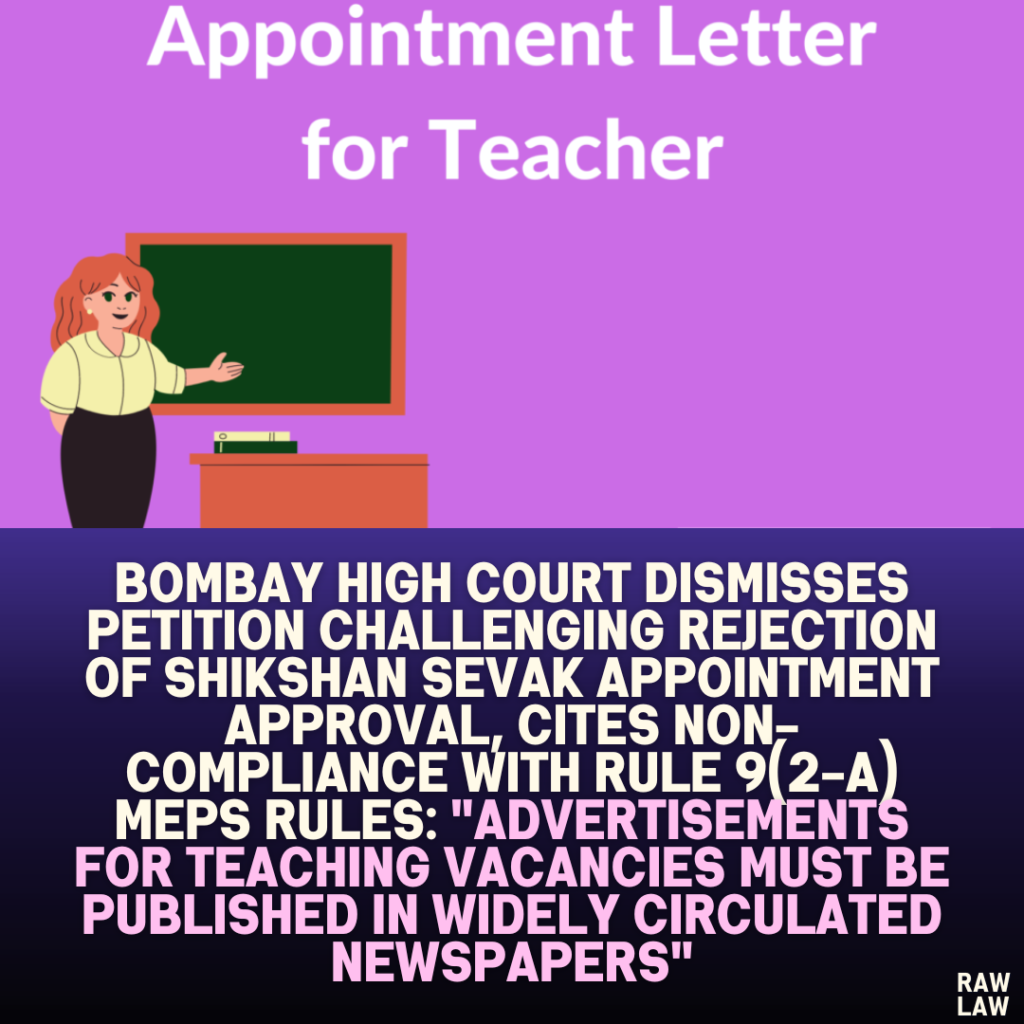Court’s Decision
The Bombay High Court dismissed the writ petition challenging the rejection of approval for the appointment of a Shikshan Sevak in a minority educational institution. The Court held that the advertisement for the post violated Rule 9(2-A) of the Maharashtra Employees of Private Schools (MEPS) Rules, 1981, as it was published in a fortnightly newspaper with limited circulation, failing to meet mandatory requirements. The Court emphasized that such non-compliance undermines transparency and violates Article 16 of the Constitution, which ensures equal opportunity in public employment.
Facts
- Petitioners: Petitioner No. 1 (candidate for Shikshan Sevak) and Petitioner No. 2 (management of a minority educational institution) sought approval for the appointment in a secondary school receiving 100% government aid.
- Vacancy and Selection Process: A vacancy arose upon the retirement of a teacher. Despite applying for a no-objection certificate (NOC), the management proceeded to publish an advertisement in a fortnightly newspaper, inviting applications. Petitioner No. 1 was selected and appointed based on interviews conducted by the School Committee.
- Proposal for Approval: A proposal was submitted to the Respondent (Education Officer), which was rejected for non-compliance with procedural and legal requirements.
Issues
- Whether the advertisement published complied with Rule 9(2-A) of the MEPS Rules, 1981.
- Whether the impugned rejection order suffered from legal infirmities warranting interference by the Court.
Petitioner’s Arguments
- The advertisement was published before the Government Resolution (GR) dated 10/06/2022 and should not be subjected to its requirements.
- Compliance with Rule 9(2-A) was substantially met, and the fortnightly newspaper had adequate circulation.
- The Teacher Eligibility Test (TET) was not required for the post, citing judgments exempting minority institutions from such eligibility conditions.
Respondent’s Arguments
- The advertisement lacked details about eligibility criteria and was not published in a widely circulated newspaper, as mandated by Rule 9(2-A).
- Approval could not be granted as the selection process violated transparency requirements and the fundamental rights of equal opportunity in public employment.
- Discrepancies in the appointment letter, including a lower pay scale, further raised doubts about the selection process.
Analysis of the Law
- Rule 9(2-A) of MEPS Rules: The rule mandates advertisements for teaching vacancies to be published in widely circulated newspapers to ensure equal opportunity. The fortnightly newspaper “Bharatiya Nagrik” did not meet these requirements.
- Transparency in Recruitment: As public funds are involved in aided institutions, the selection process must align with constitutional principles under Article 16. The Court noted previous patterns of procedural violations in teacher appointments.
- Judicial Precedents:
- Pravin Bhodhu Kasbe Case: Advertisements failing to meet legal requirements render recruitment invalid.
- Shreeya Nitin Sawant Case: Similar practices of non-compliance were termed as an “eye wash,” defeating the purpose of fair and transparent recruitment.
Precedent Analysis
The Court relied on judgments emphasizing adherence to statutory provisions for recruitment in aided institutions. Non-compliance with Rule 9(2-A) has consistently been held as a violation undermining public employment principles.
Court’s Reasoning
- The advertisement’s failure to comply with mandatory requirements under Rule 9(2-A) rendered the selection process invalid.
- Transparency and fairness in public employment were compromised, defeating the purpose of ensuring equal opportunity.
- Procedural defects, including lack of proper publication and omission of eligibility details, constituted violations warranting rejection.
Conclusion
The Court dismissed the petition, upholding the rejection of the appointment’s approval. It emphasized that non-compliance with statutory rules undermines the integrity of recruitment processes and violates constitutional principles. The Court directed strict adherence to recruitment norms in future cases.
